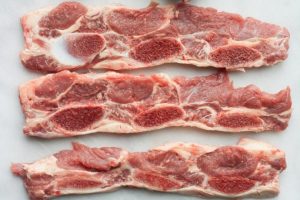
One of the best things about Hawaii is the food and often that means plate lunch! Now plate lunch is both uniquely Hawaiian and a key part of the culture. Take the many asian traditions in Hawaii and add local touches and you have something that is quick, easy to grab and head to the beach, and incredibly tasty. When I lived on the Big Island my favorites places for plate lunch in Hilo were L & L’s, Blaine’s, Verna’s, Cafe 100, Leung’s or Freddie’s. Ordering was easy: pick an entrée and you got two scoops of white rice and a scoop of mac salad. [the mac salad is almost worth it by itself!] Although there are many, many good choices for entrées, one of my favorites is Kalbi beef. Tender, thinly sliced, slightly smoky, charred on the BBQ, and bathed in a sweet and salty ginger- and garlic-based soy sauce. Heaven!

As with my Huli Huli chicken recipe, I created this recipe from posts I found online plus my own additions and substitutions. The best thing about Kalbi beef is that it is fairly quick and easy to make and cook. Ideally, you should use short ribs cut thinly (about 1/4″) across the ribs; the so-called flanken cut. In Hawaii you can find this cut in most supermarkets such as KTA but it is not common everywhere else. Most stores on the mainland instead stock the english-cut short ribs which are good for braising, not BBQ.

Because of its rarity in California I have used thinly sliced chuck steak which in some places (like Costco) you can find available as pre-cut for Carne Asada. Both types of meat work nicely, and others may work as well, but I prefer the short ribs for their richer bone-in flavor. The key issue is that the meat needs to be thinly sliced, to allow the marinade to penetrate into the meat as much as possible, and to cook quickly and evenly over a hot grill.
For this recipe you need about two pounds of meat which you should place in the marinade for an hour or two in a bowl (or zip-lock bag) in the refrigerator. Beyond two hours it probably don’t make much of a difference (to know why see Meathead’s amazing new BBQ book!).

Marinade:
- 3/4 cup shoyu sauce (or soy sauce)
- 1/4 cup mirin
- 1/4 cup scallions, finely chopped
- 1/4 cup cane or brown sugar
- 2-3 tbsp garlic, finely minced
- 2 tbsp ginger, grated
- 2 tbsp dark sesame oil
- 1 tbsp sesame seeds, toasted
- 1/4 tsp black pepper
I strongly recommend shoyu sauce (especially Aloha Shoyu) as it has a milder flavor then most other soy sauces. Fresh garlic and ginger are key to the recipe but powered substitutes will work in a pinch. Other variations of the sauce include adding grated fruits such as pineapple or asian pear to make it sweeter and Sriracha or Gochujang to add some heat.
 When you are ready, cook the meat quickly over high heat on the grill. I use mesquite or kiawe wood as it compliments the sweet and salty flavor of the meat. It should only take about 10 minutes to cook; turn it often, especially since the fat can cause flare-ups, until it has a nice char.
When you are ready, cook the meat quickly over high heat on the grill. I use mesquite or kiawe wood as it compliments the sweet and salty flavor of the meat. It should only take about 10 minutes to cook; turn it often, especially since the fat can cause flare-ups, until it has a nice char.
Serve with rice, mac salad or whatever you like. Enjoy!


4 responses to “BBQ With Aloha: Hawaiian Kalbi Beef”
Hi Dr. Ab,
I share your monomania concerning abalone, and HI plate lunches. I will on Oahu tomorrow and will be sure to hit the local plate lunch establishments on the North Shore following dives at Waimea Bay and Shark’s Cove. Thanks for the recipes.
So, I know that black abs are black, and red abs are red, and some green abs are green, but it seems that pinks and whites are quite inappropriately named. Were pinks and whites named for inner shell coloration? Corrugates seems like a much more appropriate name for the pinks, but I guess the field biologists wanted to stay with the “color” connection naming modality.
Mark
Hey Mark, Good point about abalone names. In Baja they call greens “blue” abalone (abulón azul) due to the colors in their shells and pinks are “yellow” (abulón Amarillo) due to the color of their foot. But whites are still whites, I assume due to their interior shell color. Sometimes common names make sense, sometimes they don’t. At any rate thanks for your comments and I hope you have a great time on the north shore! Aloha — Brian
[…] and gave rise to many of the local customs and the local dishes such as the loco moco at Cafe 100, plate lunch at Leung’s, pancakes at Ken’s, and spam […]
I made this Hawaiian bbq steak for the first time. My fiance and I loved it!!! Taste very good!!! I made it again today. I left them in the fridge overnight. Let’s see if it’s really tasty by tomorrow!